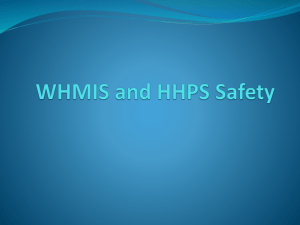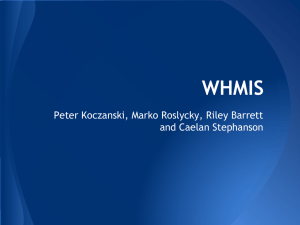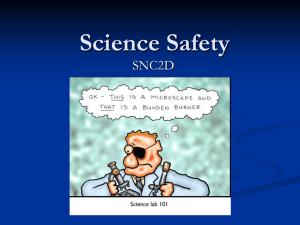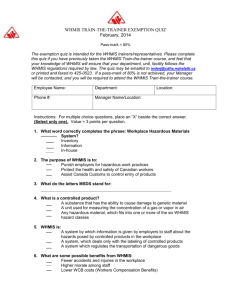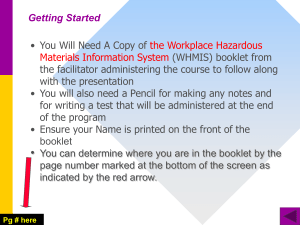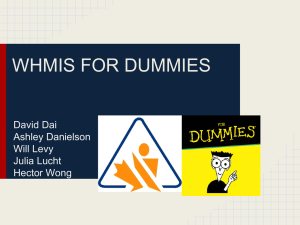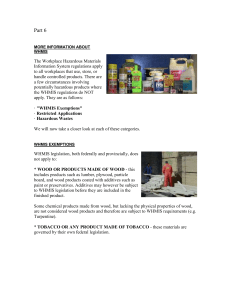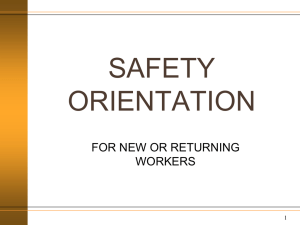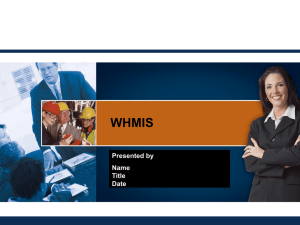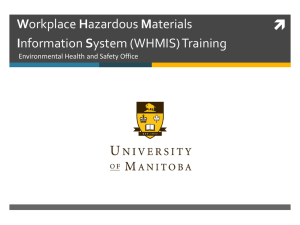WHMIS
advertisement
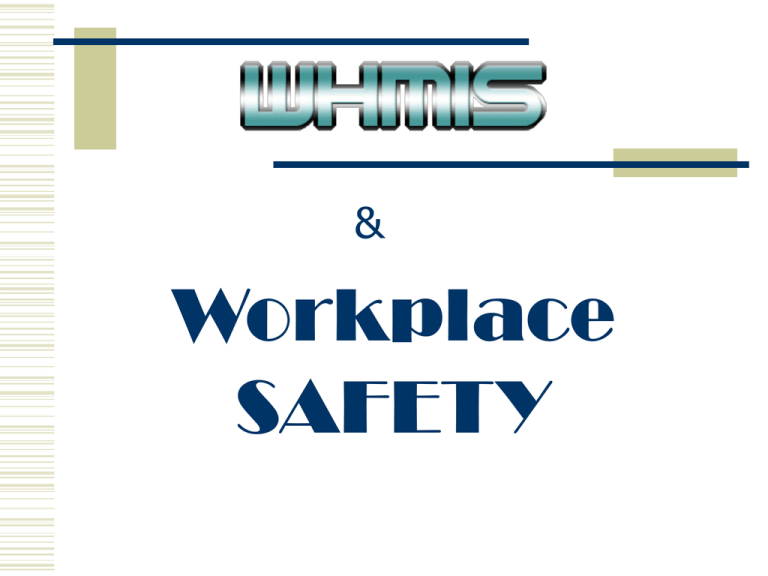
& Workplace SAFETY KNOW AND IDENTIFY Workplace Hazardous Materials Information System Symbols for products used in Workplaces WHAT INFORMATION DOES WHMIS PROVIDE? WHMIS provides information through: LABELS on containers of controlled products MSDS for each controlled product EDUCATION on how WHMIS works and responsibilities What is WHMIS ? The Workplace Hazardous Materials Information System (WHMIS) is Canada's hazard communication standard. What are the main parts of WHMIS? The main components of WHMIS are: Labeling - hazard identification and product classification material safety data sheets, and worker training and education. Workers Legal Rights Right to Know Right to Participate Right to Refuse Unsafe Work Why was WHMIS created? It was created in response to the Canadian workers' right to know about the safety and health hazards that may be associated with the materials or chemicals they use at work. Exposure to hazardous materials can cause or contribute to many serious health effects such as effects on the nervous system, kidney or lung damage, sterility, cancer, burns and rashes. Some hazardous materials are safety hazards and can cause fires or explosions. WHMIS was created to help stop the injuries, illnesses, deaths, medical costs, and fires caused by hazardous materials. What are controlled products? Controlled products is the name given to products, materials, and substances that are regulated by WHMIS legislation. All controlled products have levels of danger designated by border shapes All controlled products fall into one or more of six WHMIS classes. The level of danger Like street signs have shapes to indicate the level of threat, so too do the WHMIS symbols. A Red Octagon This symbol is the strongest warning level, it means DANGER. Just like a stop sign, its’ purpose is to provide a strong warning about the contents. The Orange Diamond This symbol is a moderate message of the danger level, it means WARNING. While less serious than DANGER, this can still cause serious injury or harm depending on the product. The Yellow Triangle This is the lowest of the three threat levels, CAUTION. However, anything with a WHMIS label is dangerous or toxic in some way, and must always be handled with care. The 6 WHMIS classes: 1. Class A: Compressed gas 2. Class B: Flammable and Combustible material 3. Class C: Oxidizing material 4. Class D: Poisonous and Infectious materials Division 1 (D1) - Materials Causing Immediate and Serious Toxic Effects Division 2 (D2) - Materials Causing Other Toxic Effects Division 3 (D3) - Biohazardous Infectious Material 5. Class E: Corrosive material 6. Class F: Dangerously Reactive material COMPRESSED GAS Class A A compressed gas is a gas at room temperature 20 oC and pressure, packaged as a pressurized gas by compression or refrigeration and is usually quite heavy. The potential hazard of compressed gases occurs when sudden rupturing of the container causes it to become a dangerous projectile. Includes such things such as Propane and Acetylene bottles, as well as Oxygen tanks. FLAMMABLE Class B Flammable or combustible materials will ignite and continue to burn if exposed to a flame or source of ignition. Flammable materials will burn easily at or about room temperature (Flash point 38 degrees C or below) Combustible material will burn when heated Oil and Gasoline are examples of flammable materials. Materials are classified as Flammable Gases: -propane and hydrogen. Flammable Liquids: - gasoline and BBQ starter fluid Combustible Liquids: - paint thinner and diesel fuel Flammable Aerosols: - hair spray, engine starter fluid and penetrating oil Reactive Flammable Materials: - celluloid and metallic sodium Combustible Solids: - Wood and paper. OXIDIZING Oxidizing material may or may not burn itself, but will release oxygen or another oxidizing substance, and thereby causes or contributes to the combustion of another material. Oxidizing material has to be stored in special containers and must be transported with extreme care. Ozone, Chlorine, and Nitrogen Dioxide are oxidizing materials which support a fire and are highly reactive. POISONOUS Materials Causing Immediate and Serious Toxic Effects Class D-1 This symbol is the most common found symbol in homes It is found on materials that are toxic when ingested These materials may be classified as toxic or very toxic based on information such as LD50 Bleach, Mr. Clean, Tide, Cyanide and rat poisoning are very toxic. Most household chemicals and cleaners contain this symbol TOXIC Materials Causing Other Toxic Effects Class D-2 A pure substance or mixture that may be any one of the following: a carcinogen, a teratogen, a reproductive toxin, a respiratory tract sensitizer, an irritant or a chronic toxic hazard. Chemicals that fit into this category cause slower effects to the body. Asbestos, Arsenic and Nicotine are toxic substances. BIOHAZARDOUS This classification includes any organisms and the toxins produced by these organisms that have been shown to cause disease, or are believed to cause disease in either humans or animals. These hazards are often found in hospitals and on products and materials that are harmful, such as viruses or bacteria Blood sample containing the Hepatitis B Virus is a biohazardous infectious material because it may cause hepatitis in people exposed to it Ebola and Flesh-eating disease are also biohazardous CORROSIVE This symbol is the 2nd most common symbol found in homes across North America. It is found on products which corrode (eat away) metals or cause permanent damage to human tissues such as the skin and eyes on contact by burning, scarring or blinding. Corrosive materials may also cause metal containers or structural materials to become weak, leak or collapse. Bleach, Battery Acid, Ammonia and Hydrochloric Acid are examples. DANGEROUSLY REACTIVE Certain chemicals when mixed, undergo vigorous reactions and can produce harmful side effects. They may react violently under conditions of shock, or when there is an increase in pressure or temperature. They may also react vigorously with water to release a toxic gas. Chemicals that should not be mixed are bleach, drain cleaner, and ammonia because, when combined, they form a toxic gas. Labeling controlled products Under WHMIS regulations most controlled products must be labeled. Supplier labels and workplace labels are the only two types used in WHMIS. All WHMIS labels have to be clear, easy to read and prominently displayed on the product container. Supplier labels Display these seven pieces of information: material identification number or product name - this is a designation or identification of a material, supplier's name and address, reference to the material safety data sheet (MSDS) for more information, WHMIS hazard symbols for each of the classes to which the product belongs, main hazards of the product including risk phrases appropriate to the class of material, precautionary measures, first aid measures. Both French & English Workplace labels This label does not need as much information as the supplier label: material identifier or product name, reference to a material safety data sheet (MSDS) for further information, information on how to use the product safely. Language of workplace Material Safety Data Sheets (MSDSs) WHMIS MSDSs have nine categories of information: Section 1 - Product Information: including identification and use Section 2 - Hazardous Ingredients: listing of ingredients considered hazardous as well as each ingredient's concentration, etc. Section 3 - Physical Information: form, odor, appearance, pH, etc. Section 4 - Fire or Explosion Hazard: conditions of flammability, flash point, etc. MSDS Section 5 - Reactivity Information: conditions of instability, reactivity, decomposition, etc. Section 6 - Health Hazard Information: route of entry, effects of exposure, exposure limits, etc. Section 7 - Preventive Measures: personal protective equipment, waste disposal, storage, etc. Section 8 - First Aid Measures Section 9 - Preparation Information and Update: person who wrote MSDS, date of preparation NOTE: MSDS sheets must be updated at least every three years WHMIS is Law WHMIS became law effective October 31, 1988. This applies to all of Canada. WHMIS legislation includes: the HAZARDOUS PRODUCTS ACT and the HAZARDOUS MATERIALS INFORMATION REVIEW ACT. In Newfoundland: Occupation Health and Safety Act Workplace Hazardous Materials Information System (WHMIS) Regulations What are our duties under WHMIS? According to the Hazardous Products Act the following groups have specified responsibilities. Suppliers, Employers and Workers A Suppliers duty... Canadian suppliers are those who sell or import products. When this product is considered a "controlled product" according to the WHMIS legislation, a supplier must: label the product or container, must provide a material safety data sheet (MSDS) to their customers. An Employers duty... Employers are required to establish education and training programs for workers exposed to hazardous products in the workplace. Employers must: make sure that the products are labeled, that an MSDS is present for each product and that they are readily available to workers, Workers are trained in WHMIS A Workers duty... Workers are required to: participate in WHMIS training programs and to use this information to help them work safely with hazardous materials. They may also inform employers when labels on containers have been accidentally removed or if the label is no longer readable. Hazardous Household Product Symbols (HHPS) Designed for use on household products Indicates to what degree and why a product is dangerous & Workplace SAFETY The END
